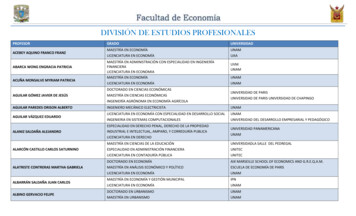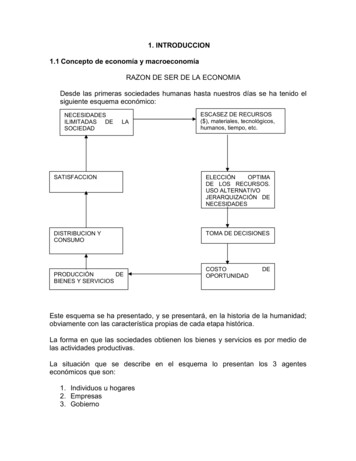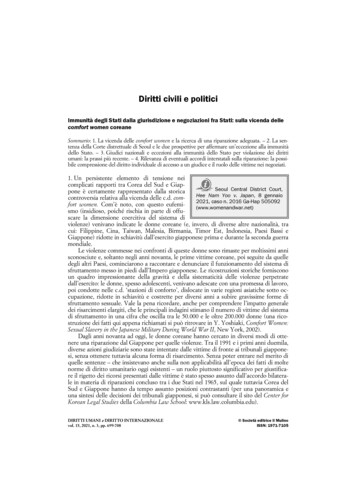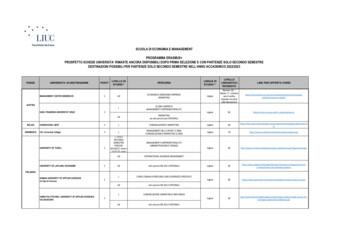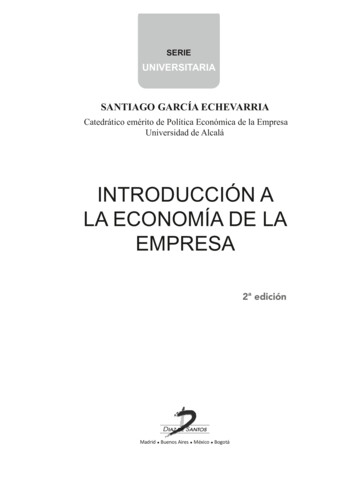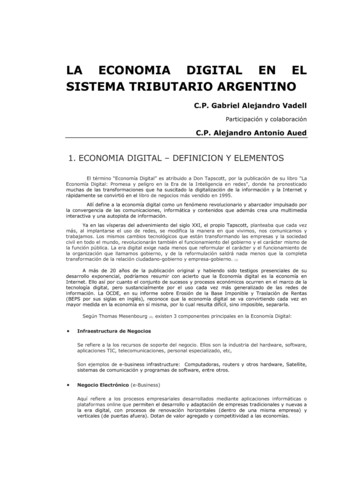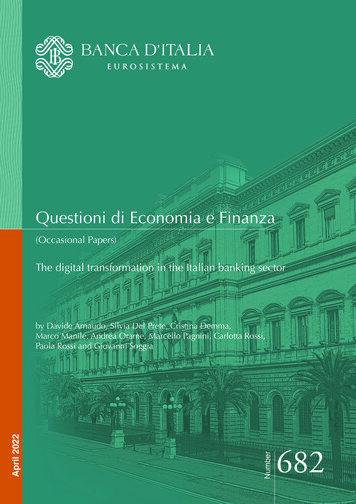
Transcription
Questioni di Economia e Finanza(Occasional Papers)The digital transformation in the Italian banking sectorNumberApril 2022by Davide Arnaudo, Silvia Del Prete, Cristina Demma,Marco Manile, Andrea Orame, Marcello Pagnini, Carlotta Rossi,Paola Rossi and Giovanni Soggia682
Questioni di Economia e Finanza(Occasional Papers)The digital transformation in the Italian banking sectorby Davide Arnaudo, Silvia Del Prete, Cristina Demma,Marco Manile, Andrea Orame, Marcello Pagnini, Carlotta Rossi,Paola Rossi and Giovanni SoggiaNumber 682 – April 2022
The series Occasional Papers presents studies and documents on issues pertaining tothe institutional tasks of the Bank of Italy and the Eurosystem. The Occasional Papers appearalongside the Working Papers series which are specifically aimed at providing original contributionsto economic research.The Occasional Papers include studies conducted within the Bank of Italy, sometimesin cooperation with the Eurosystem or other institutions. The views expressed in the studies are those ofthe authors and do not involve the responsibility of the institutions to which they belong.The series is available online at www.bancaditalia.it .ISSN 1972-6627 (print)ISSN 1972-6643 (online)Printed by the Printing and Publishing Division of the Bank of Italy
THE DIGITAL TRANSFORMATION IN THE ITALIAN BANKING SECTORby Davide Arnaudo, Silvia Del Prete, Cristina Demma, Marco Manile, Andrea Orame,Marcello Pagnini, Carlotta Rossi, Paola Rossi and Giovanni Soggia*AbstractUsing a unique dataset based on the results of a survey of almost 280 Italian banks(Regional Bank Lending Survey), this paper presents early evidence on the digitaltransformation of the Italian banking sector over the period 2007-2018. By building acomposite indicator that measures the digital supply of financial services, we show a growthin digitalization over the entire period, with a clear acceleration since 2013. The adoption ofdigital technologies is not homogeneous across banks and, to an even greater extent, businessareas: digitalization started in payment services at the end of the 1990s and then spread toasset management, whereas the use of digital channels in lending is still less frequent. Morerecently, banks have also implemented new FinTech projects, mainly for digital payments andasset management activities. Lastly, we find a positive correlation between the intensity oftechnological innovation and bank profitability, and a negative correlation with the number ofbranches, signalling a potential substitution effect between physical and digital channels.JEL Classification: G10, G21, G23, L86, O33.Keywords: banking system, Big Data, financial services, FinTech, technological innovation.DOI: 10.32057/0.QEF.2022.0682Contents1. Introduction . 52. Literature review . 63. Stylized facts on bank digitalization. 84. The ICT transformation of the Italian banking industry . 94.1 The digitalization of banking services . 94.2 FinTech banks . 104.3 Information technology and Big Data . 115. A metric for the digital transformation . 116. Digitalization and bank performances . 127. Digital transformation and debranching . 148. Conclusions . 16References . 18Appendix: Figures and tables . 21* The authors are affiliated with Bank of Italy, Milan Branch (Davide Arnaudo and Paola Rossi), FlorenceBranch (Silvia Del Prete), Palermo Branch (Cristina Demma), Campobasso Branch (Marco Manile), TurinBranch (Andrea Orame), Bologna Branch (Marcello Pagnini), Financial Education Directorate (Carlotta Rossi)and Cagliari Branch (Giovanni Soggia).
1. Introduction1In recent years, technological innovation has contributed to the structural change of the bankingsystem worldwide. This development was already in place before the Covid-19 pandemic. The digitaltransformation proved crucial during the pandemic to assure a smooth access to financial services bybank customers. Even though the analysis conducted in this paper concerns the period prior to thepandemic, its results are useful to understand the resilience of the Italian banking industry during theCovid-19 crisis.2International statistics show that Italy is still lagging behind with respect to other Europeancountries, considering both the use of digital financial services by customers and the level of FinTechinvestments; the Italian digital gap appears particularly substantial when compared to the UnitedKingdom and to countries in Northern Europe.Studying the effects of the ICT-related transformation in the banking sector is notstraightforward. On the one hand, digital innovation and technology-based business models open upnew opportunities for financial intermediaries by transforming the delivery of products and services.On the other hand, ICT could disrupt the existing structure and organization of the financial industryby blurring its boundaries and setting in place a disintermediation process. Moreover, ICT-relatedservices in banking can foster competition from new intermediaries. In order to survive, incumbentbanks will thus have to cope with increasing competitive pressure and to adopt innovative yet costlystrategies.In this paper we describe the ICT-driven transformation of the Italian banking sector by using aunique dataset based on a survey on a large sample of Italian banks. Through the survey, we are ableto analyse the supply side of this digital transformation, considering different business areas (i.e.payments, lending and saving management). We also provide a detailed picture, updated to 2018, onbank investments in FinTech (crypto assets, e-wallets, crowdfunding, cloud-computing, etc.) and inBig Data, i.e. those techniques that allow banks to elaborate and exploit the digital footprints createdthrough the interactions with their customers. To the best of our knowledge, this paper is the firststudy to depict an overview of the ICT-driven transformation of the supply of financial services byItalian banks.Our evidence shows that the adoption of digital technologies is far from being homogeneousacross business areas and bank categories. Digitalization started in payment services: in 2018 all thebanks supplied digital payment services and three-fourth of them provided also online micropayments. The digital transformation was widespread also in asset management and nearly 60 percentof the banks in the sample used digital channels in this business area. On the contrary, banks startedto offer online loans only later on: in 2018, less than 30 percent of banks was lending online tohouseholds, and less than 10 percent to firms. The digital intensity (i.e. the possibility to almostcompletely finalize a financial operation or a contract digitally) reflected these differences and it wasquite poor for the contracts of residential mortgage. As expected, the supply of financial services1The authors wish to thank Emilia Bonaccorsi di Patti, Nicola Branzoli, Giorgio Gobbi, Ilaria Supino and Valerio Vaccafor useful comments and suggestions. The views and the opinions expressed in this paper are those of the authors and donot necessarily represent those of the Bank of Italy.2First evidence on the impact of the pandemic crisis on the banking system, in particular on the most innovative paymentservices, is shown by Ardizzi et al., 2021.5
through digital channels was common especially among large banks (classified as significant forsupervisory purposes), less among smaller intermediaries.More recently, banks implemented also FinTech projects: in 2018 around half of the banksinvested in technologically innovative processes, especially for digital payments and assetmanagement activities, which are perceived as strategic areas of business by most of the Italian banks.These projects were mainly aimed at improving cross-selling strategies, while the use of Big Data inthe lending process, to evaluate the creditworthiness of borrowers, was less frequent.We provide a metric for monitoring the digital transformation of the Italian banking industry bybuilding a composite indicator, which considers both the number of online services actually providedby each bank and the lag since the first-time adopter. The trend of this indicator shows a gradualgrowth in the supply of financial services through digital channels over the period 2007-2018, withan acceleration starting in 2013.The digital transformation in the banking sector is frequently associated with improved bankprofitability and debranching. With the aim to investigate these topics, we also use the Bank of Italy’sSupervisory Reports, which contain information on bank branches, profitability, riskiness,capitalization, size, institutional form, headquarters’ location, home banking contracts and onlinetransfers. We study both the correlation between digital transformation and bank performance overthe period 2007-2018, and between digital transformation and the structure of banks’ geographicalnetwork in 2018. In the latter exercise, we consider a) the number of branches owned by each bank,b) the lender-borrower distance, c) the distance between the bank’s central headquarters and its localbranch managers. We find a positive correlation between digital innovation and profitability, mainlydriven by the generation of new sources of income. However, this transformation might be costly andit requires time to bring about cost saving results, essentially via a revision of the traditional supplychannels. Furthermore, results show a negative correlation between the degree of digitalization andthe number of branches, signalling a potential substitution for bank supply between physical anddigital channels.The rest of the paper is organized as follows. Section 2 reviews the main literature on the topic,while Section 3 shows some international evidence. Section 4 describes the digital transformation ofthe Italian banking system since the end of the 1990s in terms of supply of banking services andinvestments in FinTech and Big Data. In Section 5 we propose a composite indicator whichsynthesizes the degree of digitalization of bank services. Section 6 and Section 7 analyse thecorrelation between digital innovation and bank performance and between digital innovation and thestructure of the branch network, respectively. Finally, Section 8 highlights some concluding remarks.2. Literature reviewDespite the digitalization of financial services is attracting increasing attention from academicsand policymakers, evidence of its effect on banks is still mixed (see, for a wide review, Abbasi andWeigand, 2017). The digitalization of financial services can affect banks’ performances in manyrespects. It may offer significant cost-saving opportunities in the distribution of financial services inthe medium-long term and can improve credit risk models by using new data and methods that areparticularly helpful in screening opaque and riskier borrowers (Branzoli and Supino, 2020). However,it may entail new business opportunities for more innovative banks and non-financial institutions6
investing in FinTech activities, thus increasing the competitive pressure stemming from newcompetitors and new products (Philippon, 2016; Barba Navaretti et al., 2017; Buchak et al., 2017).Therefore, the digitalization of financial services opens a window for new players in the financialindustry, giving access to tasks and functions previously reserved to banks, such as lending, paymentsor investment. Differently from other emerging industries, banks reacted mainly by undertakingstrategic partnerships with FinTechs, postponing the decision to modernize their own ICTinfrastructure (Brandl and Hornuf, 2017).Consequently, the advance of digitalization in finance generates a trade-off affecting bankperformance, stemming from new revenues in new market segments, requiring significantinvestments in digital technologies and human capital, as well as the increasing threat posed by thecompetition from new FinTech players.3As far as European banking systems is concerned, virtual banks may pose a credible challenge fortraditional banks. Arnaboldi and Clayes (2010) examine the strategic choices of a sample of large EUbanking groups with respect to online services, considering the supply of direct online facilities versusthe creation (or acquisition) of a separate internet bank. They find evidence that banks with a heavycost structure, a large market share in retail deposits and a high ratio of non-interest income on totalassets are more likely to supply directly internet banking facilities, while competitive pressure seemsto drive towards the establishment of a separate internet bank within the banking group. However,banks seem to gain few synergies from a separate internet bank, whereas mixing online to traditionalbanking seems to improve cross-selling possibilities, despite smaller cost savings. Concerning theUnited States financial systems, Dandapani et al. (2018) suggest that credit unions adopt transactionalinternet banking (i.e. customers can buy and use services online) when they serve many customersand when there is increased competition from other financial institutions. Credit unions usetransactional internet banking to attract new customers and to limit competitive pressure, a strategyconsistent with profit-maximization behaviour.Some studies for Italy and worldwide show that banks investing more in ICT capital increase theirproductivity (Casolaro and Gobbi, 2007), are more prone to offer high value-added services (Cicirettiet al., 2009), and are able to implement strategies of revenues diversification, offering to theircustomers new products or old ones by the new digital channels (DeYoung et al., 2007; Hernandoand Nieto, 2007).The digitalization of financial services interacts directly with the structure of the branch network,affecting the borrower-lender distance and the centre-periphery distance within the bank organization.As for the physical branches, there is a debate about the possibility that digitalization acted as acomplement (Xue et al., 2011; Campbell and Frey, 2009; Ciciretti et al., 2009) or a substitute(Bonaccorsi di Patti et al., 2003; Carmignani et al. 2020; Galardo et al. 2021) for the brick-and-mortartransactions.4 Another stream of the literature argues that the lender-borrower distance has increased3For a new approach on the link between competition and profitability for Italian banks, see Benvenuti and Del Prete(2019).4Xue et al. (2011) and Campbell and Frey (2009), focusing on the demand side, find that physical branches and onlineaccess were complements. A similar result was obtained by Ciciretti et al. (2009), this time looking at the supply side ofItalian banks in the period 1992-2002. Bonaccorsi di Patti et al. (2003) tried to identify supply and demand effects jointly;based on their findings, the number of local branches and online access displayed an inverse relation. Carmignani et al.(2020) analysed the same nexus in the 2012-15 time span; they found that the reduction in bank branches was moreintense in those local markets where the digital baking services was spreading faster (substitution effect). Recently,7
in recent years and ICT adoption and digitalization might be one of the main driver for this trend.5Finally, other contributions show that more ICT-intensive banks increased their span of control overtheir geographical network, interacting at a longer distance with their local branch managers.63. Stylized facts on bank digitalizationDigitalization in financial services differs widely across European countries, reflecting bothsupply factors, such as the availability of internet banking platforms, and demand components relatedto the overall digitalization of the society, as well as the general trust in internet banking.According to Eurostat statistics, the share of population using internet banking is higher inNorthern Europe, especially in the Netherlands, Finland, Denmark, Sweden and Estonia where morethan 80 out of 100 people used internet banking in 2019 (Figure 1). In Italy only 36 out of 100 adultsused internet banking in the same year, having a slightly higher share in the regions of Centre-Norththan in the South (Figure 2). A survey conducted by the World Bank finds that Italy ranks poorlyeven in the use of digital technologies in accessing payments services.7 The shares of adults (at least15 years old) using digital payments, e-payment or internet banking in monetary transactions arelower in Italy than in the Euro area (Figure 3).On the one hand, greater use of internet and mobile banking, especially in Nordic countries, isassociated to less dense branch networks. On this point, Italy has a rather high number of branches inrelation to its population (Figure 4). On the other hand, the use of internet banking is generallystrongly correlated with internet diffusion, and Italy underperforms in the use of internet, too (Figure5). According to the 2019 Digital Economy and Society Index (DESI),8 Italy ranks 25th out of the 28EU Member States in terms of overall digital performance.On the supply-side, technological investments in finance (the so-called FinTech) have spreadmore rapidly in China and in the United States,9 whereas in Europe only the United Kingdom hasshown a significant development in this sector, as reported by the CBInsights survey.10 Italy performspoorly among the EU countries also in investment activity to innovate financial processes, showingthe lowest share of investments in FinTech (Figure 6).Galardo et al. (2021) have shown that banks that invest more in ICT capital close more frequently their branches,especially in those local markets where broadband connections are widespread.5Petersen and Rajan (2002) documented that, thanks to the information revolution, the distance between firms and theirlenders increased, even for opaque borrowers.6See Berger et al. (2005) for evidence on financing of US small firms. Felici and Pagnini (2008) showed that, followingthe advent of ICT, the ability of Italian banks to open branches in markets, which are distant from those where they hadbeen already established, improved.7Dermirgüç-Kunt et al., 2017.8The DESI is an index that summarizes five relevant dimensions (connectivity, human capital, use of the internet,integration of digital technology, and digital public services) of the overall digital performance of each European country.For more details: desi.9See Commette on the Global Financial System and Financial Stability Board (2017).10A company that records data on innovative and digital start-ups.8
4. The ICT transformation of the Italian banking industryTo study the evolution of ICT transformation in the Italian banking industry, we use a uniquesurvey performed by the Bank of Italy on a large sample of Italian banks (Regional Bank LendingSurvey, RBLS hereafter). The sample is composed by around 280 banks, which covers almost 90percent of deposits and 85 percent of loans to firms and households. In 2019, a section of the RBLSfocused on the digital transformation of the banking sector, including questions about the adoption ofdigitalization strategies in traditional business areas and on the relationship with the FinTech industryand the use of Big Data.Using such data, in this Section, we recognize three pillars of ICT transformation in the bankingindustry: (1) the digitalization of traditional services; (2) the adoption of new processes or the supplyof innovative products (i.e. FinTech) and (3) the use of Big Data.4.1 The digitalization of banking servicesThe digital transformation spread across different types of banking activities whit a differentspeed. Digitalization started in payment services: in 1998, one-fourth of banks in the survey alreadyallowed their clients to make or receive payments digitally; ten years later, in 2008, this ratio wasclose to 90 percent and in 2018 all the surveyed banks provided digital access to payment services(Figure 7). Moreover, in the same year, 75 percent of banks (corresponding to over 80 percent ofdeposits) allowed for online micro-payments and peer-to-peer money transfers through mobiledevices, a share that was lower than 5 percent just 4 years before. The increase in the number of banksoffering payment services through mobile devices partly reflects the favour of customers for thesetools to access banking services.Since the early 2000s, the digitalization process spread out also to asset management,11 eventhough at a slower pace than that observed for other banking services: in 2018 less than 60 percent ofthe surveyed banks placed savings products through digital channels.The use of digital channels to manage most part of the lending process began to spread only lateron: in 2018 the number of banks offering credit through internet portals was still low, close to 30percent for lending to households (either mortgage or consumer credit) and lower than 10 percent fornon-financial corporations. Around 23 percent of the interviewed banks offered consumer credit tohouseholds, while the possibility of accessing an online mortgage was slightly lower (these loanswere supplied by just under 20 percent of banks).The supply of financial services through digital channels was widespread among larger banks,especially those classified as “significant” for supervisory purposes: in 2018 all significant banksallowed customers to use online services for the management of savings; 80 percent has developedprojects for the supply of payment services via mobile devices and has allowed households to useinternet to access mortgage contracts. Compared to less significant banking groups, the gap issubstantial for savings management and lending to households.The digital intensity (i.e. the possibility to almost completely finalize an operation or a contractdigitally) was highly heterogeneous across business areas, performing poorly for residential11Digital savings management includes both online placement of financial products and the offer of automatedconsultancy services (such as, for example, through robo-advisors).9
mortgages compared to consumer credit and – to a larger extent – asset management: only around 10percent of the surveyed banks fully digitalized the residential mortgage activity; the same share was40 percent for the supply of consumer credit and 50 percent in the asset management services. Thedigital intensity was instead very high in the area of payment services. Significant intermediariesgenerally performed better than the less significant ones (Figure 8).4.2 FinTech banksThe second pillar of ICT transformation in the banking industry is related to FinTech, whichpertains to the adoption of technologically intense and innovative processes that could result in newfinancial products and services.12There are many ways through which FinTech can interact with banking. The literature on thetopic studies innovations in payment systems (including cryptocurrencies), lending (comprising P2Plending) and insurance. Blockchain-assisted smart contracts are also part of this literature (Thakor,2020).At the end of 2018, almost 55 percent of the Italian banks in the survey declared that they hadalready implemented FinTech projects or that they intended to implement them in the following threeyears (Figure 9); the share of intermediaries that had already started these projects was around 35percent.13Since bank size is important to deploy these innovations, due to initial investments and the needof highly skilled employees, FinTech diffusion tends to be higher among significant banks comparedto less significant intermediaries. Unreported results show a positive correlation between bank sizeand the implementation of FinTech investments,14 suggesting that size could be a crucial constraintto bank digitalization.FinTech projects might be adopted through initiatives within the banking groups following in–house strategies, as well as through projects shared with external companies. In this perspective,around half of the Italian significant banks indicated the use of joint-ventures or commercialagreements with specialized FinTech corporations as effective strategies to adopt FinTech.Digital payments15 (including e-wallets, peer-to-peer payments, and mobile payments) representthe business area for which FinTech is considered strategic by Italian banks (Figure 10), sinceBarba Navaretti et al. (2017) state that “FinTech refers to the novel processes and products that become available forfinancial services thanks to digital technological advancements”. More precisely, the Financial Stability Board definesFinTech as “technologically enabled financial innovation that could result in new business models, applications,processes or products with an associated material effect on financial markets and institutions and the provision offinancial services”.13Since 2017, every two years the Bank of Italy has carried out another survey to detect the state of adoption oftechnological innovations applied to financial services in the Italian financial system (more details are available at thelink: -fintech/2021/index.html). This survey has a different focusrespect to the survey used in our paper in terms of perimeter of the technologies detected and of intermediariesinterviewed, including also non-banks (for more details, see Bank of Italy, 2021).14We estimate a multivariate logistic model where the dependent variable is the implementation of FinTech investmentsin at least one of the four relevant business areas that are considered in our survey (payment systems, investment services,lending to households, lending to firms) while the regressors are the usual bank balance sheet indicators.15The label “Digital payments” represents all those payments mainly enabled by mobile devices, provided both byfinancial and non-financial institutions. Those payments have huge potential to change lives of millions of people indeveloping countries by offering financial services to the unbanked masses. Despite their potential, their developmentremains heterogeneous across countries, mainly due to perceived cyber-correlated risks. In order to ascertain the various1210
payments are the area in which banks are most likely to experience competition from non-financialenterprises. Automated services for asset management, such as automated financial consultancy androbot advisors, are also perceived as a strategic business area, particularly by larger banks.FinTech projects appear of little relevance in digital services specifically targeting firms: efactoring, commercial circuits16 and crowdfunding17 are judged relevant by less than 10 percent ofsurveyed banks. As suggested by a consolidated literature on the topic, lending to firms isinformation-intensive and the lender-specific relationship is difficult to replace, especially for smalland medium-sized enterprises (SMEs): the bank branch network could play a crucial role in this areaof business, which remains more protected by the competition of specialized FinTech intermediariesand their online platforms (Hauswald and Marquez, 2006).4.3 Information technology and Big DataThe application of technological innovation to the banking sector offers new and betteropportunities to process information collected through the interactions with customers (the so-calledBig Data).At the end of 2018, the use of Big Data (which refers to collection, systematization andexploitation projects of unstructured and large data) involved 40 percent of the Italian banks in thesurvey: around one-fourth declared to have already started to use Big Data, while 15 percent of thebanks intended to undertake these projects in the short-term (i.e. within a 3-year horizon).18Analogously to FinTech investments, the share of banks that had implemented or intended toimplement Big Data projects was higher for significant banks (table 1).The main reason why banks claim to use Big Data is to extend cross-selling (30 percent) as wellas to improve their offering through a better understanding of customers’ needs (28 percent). Theevaluation of customers in the lending process and the improvement of the information supplied tocustomers are perceived as less important.5. A metric for the digital transformationIn order to have an overall picture of the evolution of the digitalization process of bankingactivities over time, we built a composite index that considers both the number of online services(payments, financial investments, loans, and applications for mobile devices) actually provided byeach surveyed bank and the time elapsed since the initial introduction by the early adopter. The indexis normalized to have a range between 0 and 1
the medium-long term and can improve credit risk models by using new data and methods that are particularly helpful in screening opaque and riskier borrowers (Branzoli and Supino, 2020). However, it may entail new business opportunities for more innovative banks and non-financial institutions . 6
